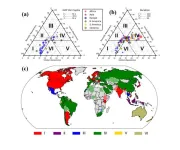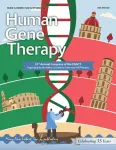(Press-News.org) London, UK, 30 August 2024: The 2024 ESC Guidelines on the management of chronic coronary syndromes (CCS) include a focus on both larger and smaller blood vessels of the heart; new models to estimate chances of blocked large arteries (so-called obstructive coronary artery disease); optimal selection and sequence of tests; drugs and interventions to prevent disease complications and improve symptoms, and the fundamental role of patient involvement.
“The new guidelines prompt cardiologists to rethink chronic coronary syndromes as caused not only by blockages in large arteries but also by dysfunction of smaller vessels (microcirculation),” explains Guidelines co-chair Professor Christiaan Vrints, Antwerp University Hospital and University of Antwerp, Antwerp, Belgium. “Over half of individuals suspected of CCS may have angina/ischaemia with nonobstructive coronary arteries (ANOCA/INOCA) caused by coronary artery spasm or microcirculatory dysfunction. This condition is often missed - on average it is diagnosed only after seeing three cardiologists - because the usual tests don't work well to detect it. Patients may suffer severely from persistent symptoms that can cause repeated hospitalisations and even heart failure.”
The guidelines highlight that persistently symptomatic patients with suspected ANOCA/INOCA who do not respond to guideline-derived medical therapy should undergo invasive coronary functional testing to determine underlying endotypes and to guide appropriate medical therapy.
A new further new recommendation strongly endorsed by the guidelines is the use of the risk factor-weighted clinical likelihood model to estimate the pre-test likelihood of obstructive coronary artery disease. With this new prediction model, around half of individuals assessed for chest pain have a very low likelihood of large artery blockage (</=5%) in whom further testing should be deferred, whereas with the ESC 2019 model, only 19% were identified as having a very low likelihood. This prediction model has been developed and validated in Western countries (northern EU, UK, and US). The results may vary depending on region, race, cultural differences, and healthcare system organisations.
For individuals with symptoms suggestive of chronic coronary syndrome who have a low to moderate (>5%–50%) likelihood of obstructive coronary artery disease based on symptoms, age, sex and risk factors, coronary computed tomography angiography (CCTA) is very effective in ruling out coronary atherosclerosis or, at the other extreme, in estimating the risk of major adverse cardiovascular events based on disease anatomy.
“Rarely, however, is a single non-invasive test sufficient to diagnose obstructive disease of the epicardial coronary arteries and a sequential approach is required. When CCTA reveals coronary blockages of intermediate severity, additional tests like stress echocardiography, stress positron emission tomography or stress cardiac magnetic resonance perfusion imaging, if available, are recommended to evaluate the functional significance of the blockages. These additional exams also help to diagnose ANOCA/INOCA when CCTA does not reveal any blockages,” explains Professor Vrints.
“In patients with large coronary artery blockages, surgical or percutaneous revascularisation is recommended for specific anatomical and/or clinical groups of patients in whom revascularisation over medical therapy alone has been shown to prolong survival and to reduce deaths from cardiovascular causes, as well as spontaneous myocardial infarctions and symptoms caused by cardiac ischaemia,” says guidelines co-chair Professor Felicita Andreotti, Fondazione Policlinico Universitario Gemelli IRCCS and Catholic University Medical School, Rome, Italy, and adds that representatives of the European Association for Cardio-Thoracic Surgery (EACTS) and representatives of the Patient Forum were included in the 28-member taskforce and that the Guidelines have been endorsed by the EACTS.
The indications for coronary revascularisation in the 2024 Guidelines are largely similar to those of 2018: namely, symptoms related to ischaemia that are refractory to medical therapy alone, and/or significant disease of the left main stem, of the proximal left anterior descending artery, or of multiple large epicardial arteries.
The Guidelines state/recommend that the most appropriate revascularisation modality should be selected based on the patient’s profile, coronary anatomy, procedural factors, patient preferences and outcome expectations. Surgery, if possible, is preferred over percutaneous coronary intervention in patients with extensive disease, especially those with diabetes or reduced left ventricular ejection fraction.
When performing revascularisation via percutaneous coronary intervention, intracoronary imaging, in addition to pressure measurements, is helpful to guide interventions and enhance immediate and long-term results, especially in complex anatomical scenarios such as left main disease, bifurcations, or long lesions.
“Percutaneous coronary intervention using modern thin-strut stents allows patients who are not at high ischaemic risk and/or who are at high bleeding risk to safely shorten the duration of dual antiplatelet therapy. In all or in certain subgroups of patients with chronic coronary syndromes, new lipid-lowering, metabolic and anti-inflammatory medical strategies have the potential to lower the risk of adverse cardiovascular events,” adds Professor Andreotti.
“Patient education and involvement in decision-making and self-care, along with mobile-health interventions and simplified medication regimens, have the potential to improve adherence to healthy lifestyles and to medical therapy, and to enhance long-term patient monitoring for disease complications and side-effects of treatment,” explains Professor Vrints.
The Guidelines co-chairs conclude: “Chronic coronary syndromes are a global health concern because a transient or long-lasting damage of the heart caused by diseases of the coronary circulation can cause ineffective heart pump function or malignant arrhythmias that can be fatal. Coronary syndromes remain the single largest cause of death in the adult population worldwide, resulting in millions dying every year. Therefore, the new guidelines stress the importance of early detection, appropriate treatment, and careful long-term follow-up.”
ENDS
Disclosures: Please see full guidelines for all disclosures.
References and notes
The “2024 ESC Guidelines for the Management of Chronic Coronary Syndromes” will be discussed during the session “2024 ESC Guidelines overview”, Friday 30 August at 8:15am BST in room London.
2024 ESC Guidelines for the Management of Chronic Coronary Syndromes, European Heart Journal, 2024, https://doi.org/10.1093/eurheartj/ehae177
ESC Press Office
Tel: +33 6 61 40 18 84
Email: press@escardio.org
The hashtag for ESC Congress 2024 is #ESCCongress
Follow us on X @ESCardioNews
Journalists are invited to become accredited and register here.
Check out the ESC Media and Embargo Policy.
About ESC Congress 2024
It is the world’s largest gathering of cardiovascular professionals, disseminating ground-breaking science both onsite in London and online – from 30 August to 2 September. Explore the scientific programme. More information is available from the ESC Press Office at press@escardio.org.
About the European Society of Cardiology
The European Society of Cardiology brings together health care professionals from more than 150 countries, working to advance cardiovascular medicine and help people lead longer, healthier lives.
END
New Chronic Coronary Syndrome (CCS) Guidelines expand diagnostic tools and ways to prevent major adverse events and enhance quality of life
2024-08-30
ELSE PRESS RELEASES FROM THIS DATE:
Atrial fibrillation guidelines focus on shared and equal care, patient empowerment, comorbidities, evidence-based management and dynamic re-evaluation
2024-08-30
London, UK, 30 August 2024: The 2024 ESC Guidelines for the management of atrial fibrillation, developed in collaboration with the European Association of Cardio-Thoracic Surgery (EACTS), contain a number of new approaches and treatment-specific recommendations to help manage the surging numbers of patients with AF worldwide.
“Atrial fibrillation (AF) is one of the most commonly encountered heart conditions, with a broad impact on all health services across primary, secondary and tertiary care,” says Guidelines Chair Professor Isabelle C. Van Gelder, University Medical Centre Groningen, Groningen, The Netherlands. “The prevalence ...
Two thirds of deaths related to high BMI are due to cardiovascular diseases - ESC Clinical Consensus Statement on Obesity and Cardiovascular Disease
2024-08-30
London, United Kingdom – 30 August 2024: The ESC Clinical Consensus Statement on Obesity and Cardiovascular Disease, presented at this year’s ESC Congress (London, UK, 30 August to 2 September) summarises current evidence on the epidemiology and aetiology of obesity; the interplay between obesity, cardiovascular risk factors and cardiac conditions; the clinical management of patients with cardiac disease and obesity; and weight loss strategies including lifestyle changes, interventional procedures, and anti-obesity medications with particular focus ...
Prehospital pulse-dose glucocorticoid in ST-segment elevation myocardial infarction
2024-08-30
About The Study: In patients with ST-segment elevation myocardial infarction, treatment with prehospital pulse-dose glucocorticoid did not reduce final infarct size after 3 months. However, the trial was likely underpowered as the final infarct size was smaller than anticipated. The glucocorticoid group had improved acute parameters compared with placebo.
Corresponding Author: To contact the corresponding author, Jasmine Melissa Madsen, MD, email jasmine.melissa.madsen.01@regionh.dk.
To access the embargoed study: Visit our For The Media website at this link https://media.jamanetwork.com/
(doi:10.1001/jamacardio.2024.2298)
Editor’s ...
Effects of sacubitril/valsartan on all-cause hospitalizations in heart failure
2024-08-30
About The Study: In this post hoc pooled analysis of 13,194 patients with chronic heart failure (HF) in the PARADIGM-HF and PARAGON-HF randomized clinical trials, sacubitril/valsartan significantly reduced hospitalization for any reason, with benefits most apparent in patients with a left ventricular ejection fraction below normal. This reduction appeared to be principally driven by lower rates of cardiac and pulmonary hospitalizations.
Corresponding Author: To contact the corresponding author, Muthiah Vaduganathan, MD, MPH, email mvaduganathan@bwh.harvard.edu.
To ...
Promising antibiotic candidates discovered in microbes deep in the Arctic Sea
2024-08-30
Antibiotics are the linchpin of modern medicine: without them, anyone with open wounds or needing to undergo surgery would be at constant risk of dangerous infections. Yet we continue to face a global antibiotics crisis, as more and more resistant strains of bacteria are evolving, while the rate of discovery of fundamentally new antibiotics has been much slower.
But there is reason for hope: 70% of all currently licensed antibiotics have been derived from actinobacteria in the soil, and most environments on Earth have not yet ...
A distinct “repair” role of regulatory T cells in fracture healing
2024-08-30
The study uncovers a unique reparative function of regulatory T cells (Tregs) in the process of fracture healing, a discovery that adds a new dimension to our understanding of the immune response in tissue regeneration. Tregs, a subset of T cells known for their role in maintaining immune tolerance and preventing autoimmunity, are now shown to play a critical part in the intricate interplay between the immune system and bone repair.
Fracture healing is a complex process that involves a sequence of events, including inflammation, repair, and remodeling. While the initial ...
Dancing galaxies make a monster at the cosmic dawn
2024-08-30
Astronomers have spotted a pair of galaxies in the act of merging 12.8 billion years ago. The characteristics of these galaxies indicate that the merger will form a monster galaxy, one of the brightest types of objects in the Universe. These results are important for understanding the early evolution of galaxies and black holes in the early Universe.
Quasars are bright objects powered by matter falling into a supermassive black hole at the center of a galaxy in the early Universe. The most accepted theory is that when two gas-rich galaxies merge to form a single larger galaxy, the gravitational interaction of the two galaxies causes gas to fall towards the supermassive ...
Drought risk and awareness gaps in global society
2024-08-30
Natural disasters have threatened to human beings and the ecosystem. Among the various natural disasters, drought is one of the most insidious and costliest, adversely affecting the global economy and livelihoods. Unlike sudden disasters such as earthquakes or hurricanes, drought is a slow-onset phenomenon that gradually intensifies. This prolonged nature of drought often results in the shortage of drinking water and the disruption of local economies.
The Slow Onset and Impact of Drought
Drought creeps in gradually, often going unnoticed until it reaches a critical stage. This slow progression makes drought particularly challenging to manage and mitigate. Initially, ...
UAF scientist’s method could give months’ warning of major earthquakes
2024-08-30
The public could have days or months of warning about a major earthquake through identification of prior low-level tectonic unrest over large areas, according to research by a University of Alaska Fairbanks scientist who analyzed two major quakes in Alaska and California.
The work was led by research assistant professor Társilo Girona of the UAF Geophysical Institute.
Girona, a geophysicist and data scientist, studies precursory activity of volcanic eruptions and earthquakes. Geologist Kyriaki Drymoni of the Ludwig-Maximilians-Universität in Munich, Germany, is a co-author.
The ...
Consensus paper: Carcinogenicity of gene therapies
2024-08-30
Researchers from the University of Pennsylvania, Perelman School of Medicine, Gene Therapy Program, and Moderna, have shown that repeated administration of lipid nanoparticle-encapsulated mRNA therapy significantly extended survival and reduced serum leucine levels in a mouse model of maple syrup urine disease (MSUD). Click here to read the article now.
The researchers, led by James Wilson, MD, PhD, from the University of Pennsylvania, Perelman School of Medicine, evaluated a lipid nanoparticle-based treatment approach to address all possible genetic mutations that can cause MSUD.
“Repeated intravenous delivery ...




